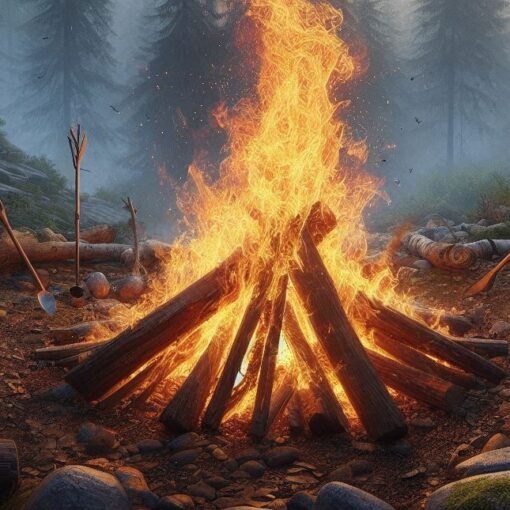Please Note: This post may contain affiliate links. If you click one of them, we may receive a commission at no extra cost to you. As an Amazon Associate, I earn from qualifying purchases.
Top Takeaways and Key Concepts
- Plan ahead before leaving home to avoid surprises like bad weather or unsafe campsites.
- Pack durable camping essentials including a sturdy tent, warm sleeping bag, and reliable cooking gear.
- Choose your campsite wisely by finding level ground away from hazards and high-traffic areas.
- Store food securely and respect nature to prevent wildlife encounters and keep the environment clean.
- Relax and enjoy your surroundings by hiking, telling campfire stories, and embracing the outdoor experience.
Summary of This Article
This article guides readers on how to camp confidently by focusing on preparation, smart packing, and safety. It emphasizes checking the weather, picking a safe campsite, and bringing reliable gear to stay comfortable. The piece also reminds campers to respect nature, store food properly, and enjoy the adventure. With careful planning and a positive attitude, anyone can turn a potential wilderness disaster into a memorable outdoor escape.
Short Video Version of this Article
So, you’ve chosen to give up your comfortable couch for the wild outdoors. Great decision! Camping may be a great way to relax and get back
in touch with nature. Unless, of course, you forget the basics and end up sleeping on a rock as insects sing to you.
Don’t be afraid! With these advice, you’ll be a great camper and not have to deal with “Survivor: The Unprepared Edition” on your vacation.
Plan Ahead (Winging It Only Works in Movies)
 Planning is the most important thing to do first. Sure, being spontaneous sounds romantic until you’re lost in the woods and wondering if that squirrel over there is really scheming against you.
Planning is the most important thing to do first. Sure, being spontaneous sounds romantic until you’re lost in the woods and wondering if that squirrel over there is really scheming against you.
– Pick Your Campsite Carefully: Look up campgrounds before you go. Look for places that have the things you need, including bathrooms (because nature calls, but you may want some privacy).
– Look at the weather: Mother Nature may be unpredictable. Pack for the weather, because a sunny prediction can soon morph into heavy rain. If it appears like it’s going to rain, you might want to buy some waterproof apparel unless you want to know what it’s like to be a damp sandwich.
Packing Essentials (Don’t Forget the Marshmallows!)
 Now that you’ve got your site picked out and checked the weather, let’s get packing. Here’s what you absolutely cannot forget:
Now that you’ve got your site picked out and checked the weather, let’s get packing. Here’s what you absolutely cannot forget:
– Tent & Sleeping Gear: Your tent should be sturdy enough to withstand wind gusts strong enough to make even Superman reconsider his choices. Also, don’t skimp on sleeping bags; no one wants to wake up shivering like they just auditioned for a horror movie.
– Cooking Supplies: Bring a portable stove or grill along with utensils. You might think cooking over an open fire is cool until you realize your hot dog is now more charred than cooked.
– Food & Snacks: Pack non-perishable items and lots of snacks because hiking burns calories—and those granola bars aren’t going to eat themselves! Don’t forget s’mores supplies; it’s basically law that camping requires marshmallows.
Set Up Camp Like a Pro
You’ve arrived at your campsite; now it’s time to set up without looking like you’ve never seen a tent before.
– Choose the Right Spot: Find level ground away from hazards (like low-hanging branches or bear dens). And please avoid setting up right next to the bathroom unless you’re okay with sharing space with every other camper who has questionable digestive decisions.
– Master Tent Assembly: Follow instructions carefully unless you enjoy wrestling with poles while trying not to scream in frustration. Trust me; there’s nothing quite as humbling as fumbling around in front of fellow campers who are watching in amused silence.
Embrace Your Inner Bear Grylls (But Maybe Not Too Much)
It’s time to enjoy nature now that your camp is set up, but keep in mind that this isn’t reality TV!
– Stay Safe: Always store food safely, and if you’re in bear area, use bear-proof containers. No one wants a surprise visitor at midnight asking for food!
– Respect Nature: Don’t leave any rubbish behind; take it all back with you and don’t disturb wildlife habitats. They were here first, and they don’t like it when others who aren’t invited go through their dwellings (or picnic hampers).
Enjoying Your Adventure
When everything is ready and safe, relax and enjoy it all!
– Get to know your surroundings: Go trekking or fishing, or just sit back and appreciate the calm (or craziness) around you.
– Get together around the fire at night to tell stories or ghost stories, like you would over a campfire. Just don’t terrify anyone too much unless they’re wearing extra layers, because then they might really pee their pants. It might make things uncomfortable.
If you plan beforehand, camping doesn’t have to be unpleasant or hard. With these guidelines in mind (and hopefully not too many bug bites), you’ll be able to enjoy nature instead of fighting it.
So get your kit together, be ready for anything, and maybe leave those expensive devices home this time? Wi-Fi won’t protect you from hungry bears, after all! Have fun camping!
Camping is a fun way to enjoy nature, but preparation is essential to avoid frustration or safety risks. By planning ahead, packing the right gear, choosing a safe campsite, and respecting wildlife, even beginners can enjoy a comfortable and stress-free outdoor adventure while staying safe and prepared.
Frequently Asked Questions
What is the first step to planning a safe camping trip?
The first step is researching and selecting a suitable campsite before leaving home, ensuring it has basic amenities and aligns with your experience level.
What essential gear should I bring for camping?
You should pack a sturdy tent, sleeping bag, sleeping pad, cooking supplies, food, water, and weather-appropriate clothing.
How do I choose the best location to set up my tent?
Select flat, dry ground away from hazards like low branches, water runoff areas, and animal paths to ensure safety and comfort.
How can I keep food safe from wildlife while camping?
Store food securely in sealed containers or bear-proof boxes, and never leave food unattended or inside your tent.
What should I do if it rains during my camping trip?
Always pack rain gear, waterproof clothing, and a rain cover for your tent to stay dry and prevent hypothermia or gear damage.
How do I respect nature while camping?
Follow Leave No Trace principles by cleaning up all trash, avoiding damage to plants and wildlife, and leaving your campsite as you found it.
What are some fun camping activities to enjoy outdoors?
Popular camping activities include hiking, fishing, stargazing, storytelling by the fire, and exploring nearby trails or scenic areas.

Kevin Collier is a seasoned outdoor enthusiast and writer for Trekbug.com, specializing in outdoor adventures, survival strategies, and prepping insights. With a deep love for nature and a commitment to self-sufficiency, Kevin empowers readers to embrace the wilderness confidently. He shares valuable tips, practical techniques, and inspiring stories, helping both novice and experienced adventurers develop essential skills for surviving and thriving in the great outdoors.





